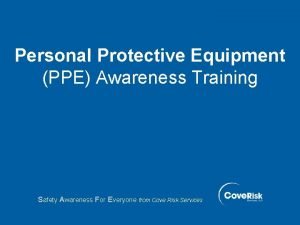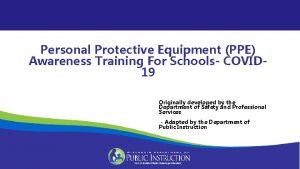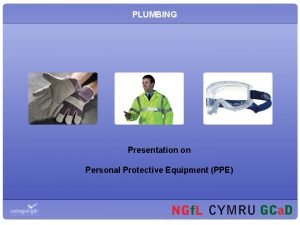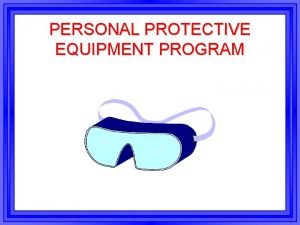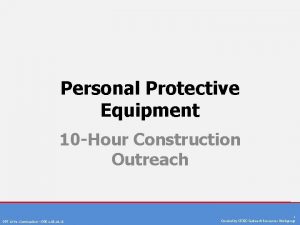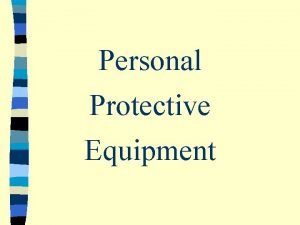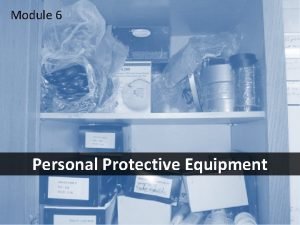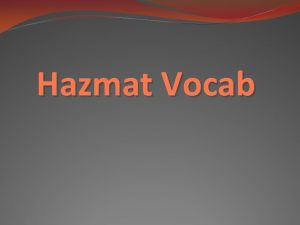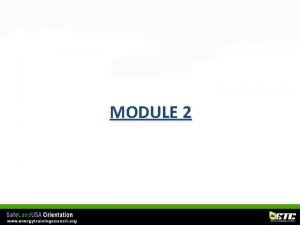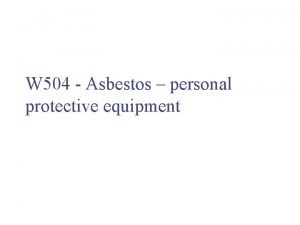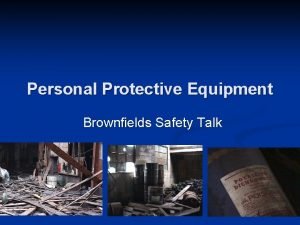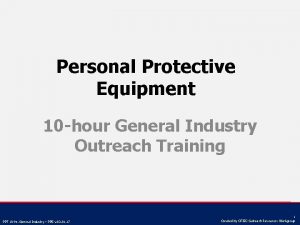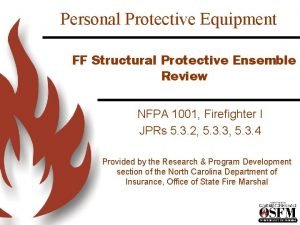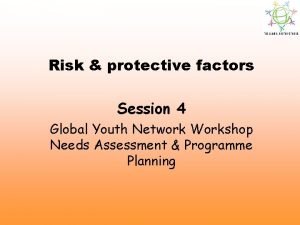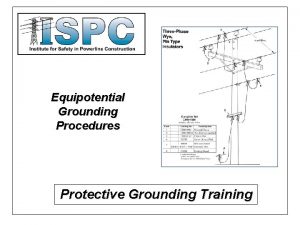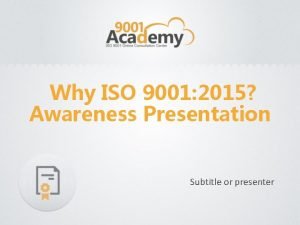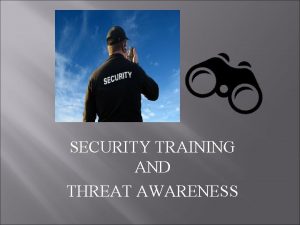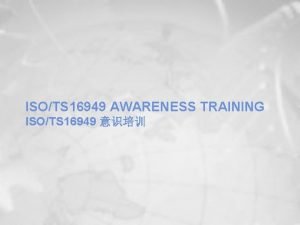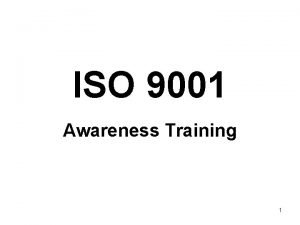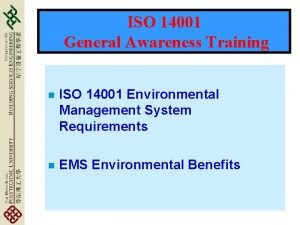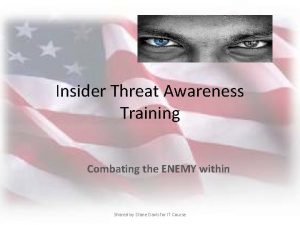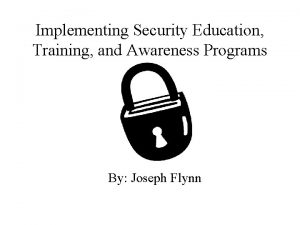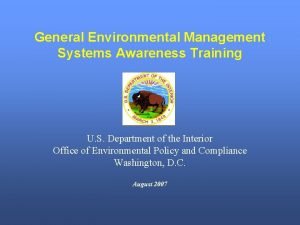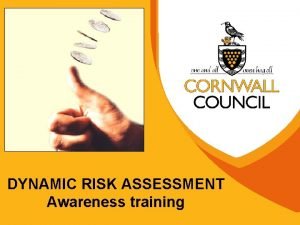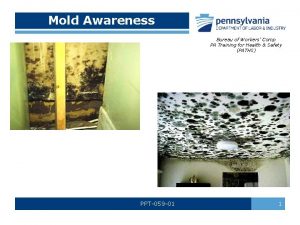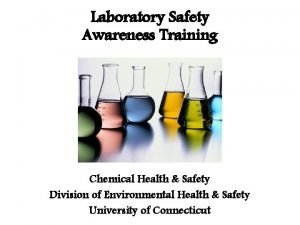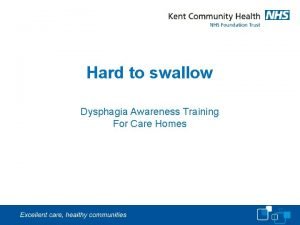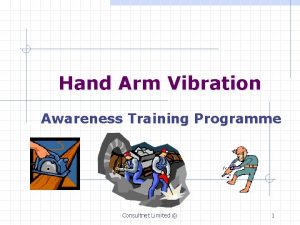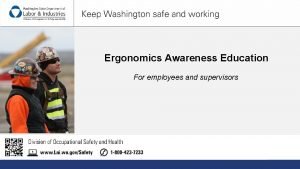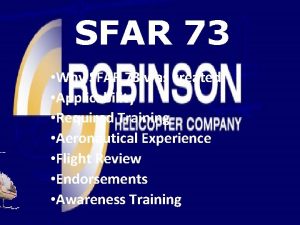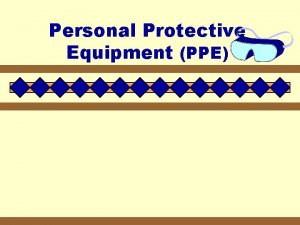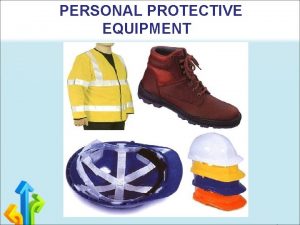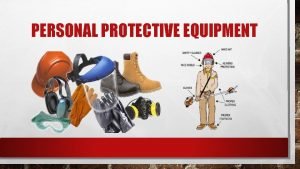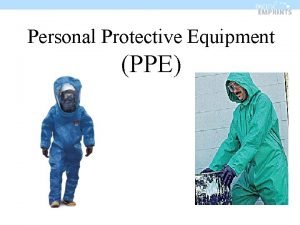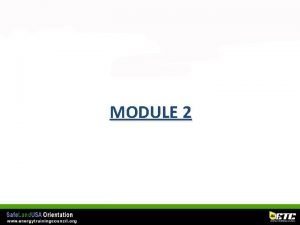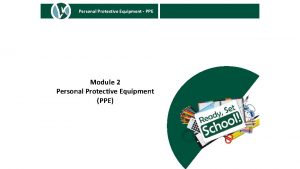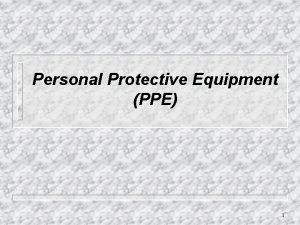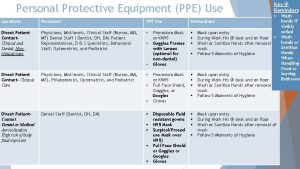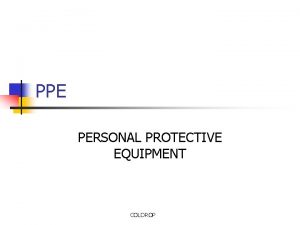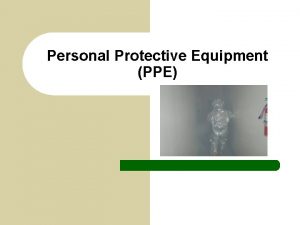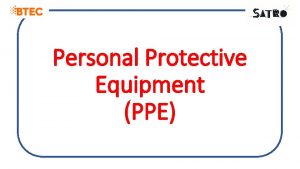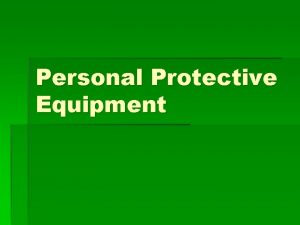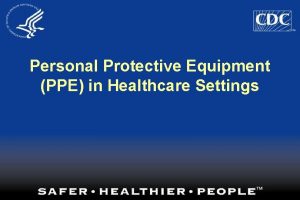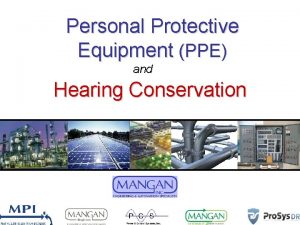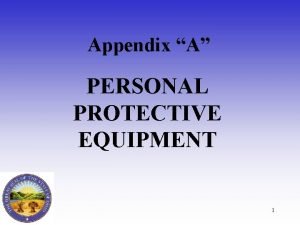Personal Protective Equipment PPE Awareness Training For Schools











































- Slides: 43

Personal Protective Equipment (PPE) Awareness Training For Schools- COVID 19 Originally developed by the Department of Safety and Professional Services - Adapted by the Department of Public Instruction

Objectives Provide information on the purpose, selection, and use of PPE in schools Based on current information – August 3, 2020

Personal Protective Equipment (PPE) Personal Protective Equipment, commonly referred to as PPE, is equipment worn to minimize exposure to hazards that cause serious injuries and illnesses.

COVID-19 • COVID‐ 19 (Coronavirus Disease 2019) is a respiratory illness that can spread easily from person‐to‐person. When a person who has COVID-19 coughs, sneezes, talks, sings, or yells they spray respiratory droplets (spit) with parts of the virus into the air and on to surfaces. • If a nearby healthy person breathes in the virus, they can become infected. • The virus can also enter a person’s body if they touch an unclean surface with the virus on it, and then touch their face, mouth, or eyes with unwashed hands.

COVID-19 and PPE • Since COVID-19 is spread via respiratory droplets extra precaution is being taken and an emphasis is being placed on protecting school staff ( and students) from respiratory droplets or sputum. • Under COVID-19 facial coverings are an infection control and mitigation measure for use by all school staff and students. Cloth facial coverings are not considered PPE by the Department of Safety and Professional Services. • Everyone is recommended to wear facial coverings to protect others from the wearer. *Currently Wisconsin is under an executive order requiring facial coverings

PPE Basics • PPE is provided by school districts (as employers) to school staff who are deemed as needing (extra) protection due to “occupational exposure”. • Certain school staff are recommended to use PPE based upon their job duties and risk of exposure to body fluids. • See your district’s Bloodborne Pathogen Exposure Control Plan – same principles exist. See DPI’s PPE Considerations for Schools

Personal Protective Equipment (PPE) Consideration for Schools Cloth Face Covering -protect others from wearer Fluid Resistant Surgical Mask -protect mouth/nose from liquid splashes N 95 or higher respirator (half/full face or PAPR) -protect mouth/nose Protective Glasses or Goggles -protect eyes from liquid splashes Face Shield -protect face, mouth, nose, and eyes from splashes Gown (Disposable)-protect clothing Lab Coat or other washable Cloth Covering (Scrub Jacket) -protect clothing Gloves- protect hands

Cloth Face Covering Cloth Face Co • May be commercially produced or improvised (i. e. , homemade) garments, scarves, bandanas, or items made from t-shirts or other fabrics • Are not considered personal protective equipment (PPE) • Will not protect the wearer against airborne transmissible infectious agents due to loose fit and lack of seal or inadequate filtration • May be disposable or reusable after proper washing • Are worn in public over the nose and mouth to contain the wearer's potentially infectious respiratory droplets produced when an infected person coughs, sneezes, or talks and to limit the spread of SARS-Co. V-2, the virus that causes Coronavirus Disease 2019 (COVID-19), to others

Cloth Face Covering • Wear a cloth face covering to help protect others in case you’re infected but don’t have symptoms • Keep the covering on your face the entire time you’re in public • The cloth face covering needs to cover nose to below chin • Don’t put the covering around your neck or up on your forehead • Don’t touch the cloth face covering when you are wearing it, and, if you do, wash your hands Should NOT be worn when: • Person is incapacitated or otherwise unable to remove the cloth face covering without assistance • The child is less than 2 years old

Surgical Mask • Are typically cleared by the U. S. Food and Drug Administration as medical devices (though not all devices that look like surgical masks are actually medical-grade, cleared devices) • Protects others from the wearer's potentially infectious respiratory droplets • Are fluid resistant and provides the wearer protection against large droplets, splashes, or sprays of bodily or other hazardous fluids • In this capacity, surgical masks are considered PPE • Under OSHA's PPE standard (29 CFR 1910. 132), employers must provide any necessary PPE at no-cost to workers • Should be placed on sick individuals to prevent the transmission of respiratory infections that spread by large droplets • Will not protect the wearer against airborne transmissible infectious agents due to loose fit and lack of seal or inadequate filtration • No fit tested required

Surgical Mask vs Cloth Face Covering Mask • Cleared by the U. S. Food and Drug Administration • Fluid resistant and provides the wearer protection against large droplets, splashes, or sprays of bodily or other hazardous fluids • Protects the patient from the wearer’s respiratory emissions • Are loose-fitting • No fit test required • No user seal check required • Does NOT provide the wearer with a reliable level of protection from inhaling smaller airborne particles and is not considered respiratory protection • Leakage occurs around the edge of the mask when the user inhales • Disposable Cloth Face Covering • Cloth face coverings may slow the spread of the virus and help people who may have the virus and do not know it from transmitting it to others • COVID-19 can be spread by people who do not have symptoms and do not know that they are infected • Cloth face coverings provide an extra layer to help prevent the respiratory droplets from traveling in the air and onto other people • Washable/reusable

Face shields protect face, noise, mouth and eyes Should cover forehead, extend below chin and wrap around side of face Disposable face shields should only be worn for a single use Reusable face shields should be cleaned and disinfected after each use Goggles or safety glasses need to be worn under a face shield NOTE: It is not known if face shields provide any benefit as source control to protect others from the spray of respiratory particles CDC does not recommend use of face shields for normal everyday activities or as a substitute for cloth face coverings Some people may choose to use a face shield when sustained close contact with other people is expected If face shields are used without a mask, they should wrap around the sides of the wearer’s face and extend to below

Eye Protection It is important to make sure that your eye and face protection is put on properly and comfortably so that you are not adjusting it with your contaminated hands or that it falls off during use

When to Use Gloves • When you are routinely cleaning and disinfecting • Follow precautions listed on the disinfectant product label, which may include: § wearing gloves (reusable or disposable) and § having good ventilation by turning on a fan or opening a window to get fresh air into the room you’re cleaning • Possible contact with Bloodborne pathogens • Use disposable gloves when touching or having contact with blood, stool, or body fluids, such as saliva, mucus, vomit, and urine • Do NOT reuse disposable gloves

For Healthcare Professiona ls (HCP) FFR N 95 Half/Full Face Respirator PAPR These respirators require: • Comprehensive program (including medical clearance, training, and fit testing) that complies with OSHA’s Respiratory Protection Standard • Program should also include provisions for the cleaning, disinfecting, inspection, repair, and storage of respirators used by HCP on the job according to manufacturer’s When to Wear: performing procedures, such as suctioning that aerosolize respiratory secretions Not everyone can use one due to their own health issues Specific training will be provided if you wear a N 95, Half/Full Face or PAPR

Filtering Facepiece Respirators (FFR) • Are used to prevent workers from inhaling small particles, including airborne transmissible or aerosolized infectious agents • Must be provided and used in accordance with OSHA's Respiratory Protection standard (29 CFR 1910. 134) • Must be certified by the National Institute for Occupational Safety and Health (NIOSH) • Require proper training, fit testing, availability of appropriate medical evaluations and monitoring, cleaning, and oversight by a knowledgeable staff member • FFRs, such as a N 95, may be used voluntarily, if permitted by the employer • If an employer permits voluntary use of FFRs, employees must receive the information contained in Appendix D of OSHA's Respiratory Protection standard (29 CFR 1910. 134)

N 95 Respirator vs PAPR Respirator- N 95 Power Air Purifying Respirator (PAPR) • Evaluated, tested and approved by NIOSH • • Reduces wearer’s exposure to particles including small particle aerosols and large droplets • • Tight fitting face seal • • Fit testing required • User seal check required each time respirator is put on • Filters out at least 95% of airborne particles including large and small particles • • When properly fitted and worn, minimal leakage occurs around respirator edges when user inhales • Single use, or replacement if damaged, deformed or soiled • Reusable components and replaceable filters or cartridges Can be used to protect against gases, vapors, or particles, if equipped with the appropriate cartage, canister or filter Battery –powered with blower that pulls air thru attached filters or cartridges Provides eye protection Low breathing resistance Loose-fitting PAPR does NOT require fit testing and can be used with facial hair Tight-fitting PAPR requires fit testing

Half & Full Facepiece Respirators Elastomeric Half Facepiece Respirator • Reusable facepiece and replaceable canisters, cartridges, or filters • Must use appropriate cartridge, canister or filter • Fit testing required Elastomeric Full Facepiece Respirator • Reusable facepiece and replaceable canisters, cartridges, or filters • Must use appropriate cartridge, canister or filter • Provides eye protection • More effective face seal than elastomeric half-facepiece respirators • Fit testing required

Put on before potential incident Key Points About PPE Use carefully – don’t spread contamination, e. g. touching surfaces with contaminated gloves Remove and discard carefully; contaminated PPE is a source of exposure to you Immediately wash your hands and/or body parts as applicable to your situation

How to Safely Put on, Use, and Remove PPE

Putting on Surgical Mask or Cloth Face Covering Correctly • Wash your hands before putting on your surgical mask or cloth face covering • Put it over your nose and mouth and secure it under your chin • Try to fit it snugly against the sides of your face • Make sure you can breathe

ACTIONS TO AVOID

Taking Off Surgical Mask or Cloth Face Covering Correctly • Untie the strings behind your head or stretch the ear loops • Handle only by the ear loops or ties • Fold outside corners together • Place washable cloth face covering in the washing machine • Place disposable surgical mask in waste container • Be careful not to touch your eyes, nose, and mouth when removing • Wash hands immediately after removing

How to Store Surgical Mask or Cloth Face Covering for Reuse • Do not place your cloth face covering in your pocket for later use • Carefully fold the cloth face covering so the contaminated outside is folded inward and against itself • Place it in a paper bag and wash your hands

Reusing Surgical Face Mask or Cloth Face Covering When putting surgical mask or cloth facial covering back on: • Perform hand hygiene before putting surgical mask or cloth facial covering back on • Be sure to grasp the surgical mask or cloth facial covering by the ear loops or strings • Perform hand hygiene after putting surgical mask or cloth facial covering on

Washing machine You can include your cloth face covering with your regular laundry Use regular laundry detergent and the warmest appropriate water setting for the cloth used to make the face covering Washing by hand How to Wash Cloth Face Covering Prepare a bleach solution by mixing: 5 tablespoons (1/3 rd cup) household bleach per gallon of room temperature water or 4 teaspoons household bleach per quart of room temperature water Check the label to see if your bleach is intended for disinfection. Some bleach products, such as those designed for safe use on colored clothing, may not be suitable for disinfection Ensure the bleach product is not past its expiration date. Never mix household bleach with ammonia or any other cleanser Soak the face covering in the bleach solution for 5 minutes Rinse thoroughly with cool or room temperature water Completely Dry cloth face covering after washing. Use dryer on highest setting Air dry. If possible, place in direct sunlight

Putting on Eye Protection and Face Shield Eye Protection • Position goggles or glasses over eyes and secure to your head using earpieces or headband Face Shield • Position face shield over face and secure on brow with headband • Adjust to fit comfortably

Removing Eye Protection or Face Shield • Grasp ear or head pieces with ungloved hands • Lift away from face • Place on clean surface for cleaning and disinfecting or dispose in appropriate receptacle

How to Clean Face Shield Using Environmental Protection Agency (EPA) and manufacturer approved cleaning agent: • Wipe front and back of face shield • Wipe elastic band • Wipe foam band • Place face shield on clean surface to dry • Once face shield is dry store in clean container

Gloves: GLOVES • Offer limited/no protection when heavily soiled, torn or have holes • Avoid “touch contamination” • Don’t touch your face or adjust PPE with contaminated gloves • Don’t touch other surfaces except, as necessary Change Gloves: • During use if torn and when heavily soiled • When contamination event is over, don’t begin another task until you have decontaminated • Discard gloves in appropriate receptacle • Never re-use disposable gloves even if you think that they are clean

Removing Gloves Step 1: • • • Step 2: Grasp outside edge near wrist Peel away from hand, turning glove insideout Hold in opposite gloved hand • Slide ungloved finger under the wrist of the remaining glove • Peel off from inside, creating a bag for both gloves Step 3: • Discard gloves

Lab Coat or Other Washable Covering • Used to protect clothing • Should be removed if becomes soiled • Should be cleaned daily per manufacturer’s directions

How to Wash Lab Coat or Other Washable Clothing • You can include your lab coat/scrub jacket with your regular laundry • Use regular laundry detergent and the warmest appropriate water setting for the cloth used to make the coat • Dry completely after washing • Use dryer on highest setting

HAND HYGIENE Perform hand hygiene immediately after removing PPE If hands become visibly contaminated during PPE removal, wash hands before continuing to remove PPE Wash hands with soap and water or use an alcohol-based hand sanitizer with at least 60% alcohol

Keep PPE SAFETY REMINDERS Avoid Remov e Limit Keep gloved hands away from your face Avoid touching or adjusting other PPE Remove gloves if they become torn; perform hand washing before putting on new gloves Limit surfaces and items touched

VIDEO DEMONSTRATION HOW TO SAFELY PUT ON PERSONAL PROTECTIVE EQUIPMENT Click HERE to open link https: //youtu. be/H 4 j. QUBAl. Br. I

VIDEO DEMONSTRATION PPE REMOVAL Click HERE to open link https: //youtu. be/PQx. Oc 13 Dxv. Q

CDC Resources CDC –About Masks. Retrieved 7/31/20 : https: //www. cdc. gov/coronavirus/2019 -ncov/preventgetting-sick/about-face-coverings. html CDC Elastomeric Respirators: Strategies During Conventional and Surge Demand Situations. Retrieved 7/31/20: https: //www. cdc. gov/coronavirus/2019 -ncov/hcp/elastomeric-respiratorsstrategy/ CDC Guidance for Child Care Programs that Remain Open. Retrieved 7/31/20 https: //www. cdc. gov/coronavirus/2019 -ncov/community/schools-childcare/guidance-forchildcare. html#Screen. Children CDC School and Child care Programs. Retrieved: 7/3//20 https: //www. cdc. gov/coronavirus/2019 -ncov/community/schools-childcare/ CDC/NIOSH - Understanding the Difference Between Surgical Masks and N 95 Respirators. Retrieved 7/31/20: https: //www. cdc. gov/niosh/npptl/pdfs/Understand. Difference. Infographic 508. pdf

References • Centers for Disease Control. (n. d. ). Sequence for putting on personal protective equipment (PPE). Retrieved August 3, 2020, from https: //www. cdc. gov/hai/pdfs/ppe-sequence. pdf • Centers for Disease Control and National Institute for Occupational Safety and Health. (2010). How to properly put on and take off a disposable respirator. Retrieved August 3, 2020, from https: //www. cdc. gov/niosh/docs/2010 -133/pdfs/2010 -133. pdf • Centers for Disease Control and National Institute for Occupational Safety and Health. (March 27, 2020). Recommended guidance for extended use and limited reuse of N 95 filtering facepiece respirators in healthcare settings. Retrieved August 3, 2020, from https: //www. cdc. gov/niosh/topics/hcwcontrols/recommendedguidanceextuse. html • Centers for Disease Control. (June 3, 2020). Use personal protective equipment (PPE) when caring for patients with confirmed or suspected COVID-19. Retrieved August 3, 2020, from https: //www. cdc. gov/coronavirus/2019 -ncov/downloads/A_FS_HCP_COVID 19_PPE. pdf • Centers for Disease Control. (June 28, 2020). Strategies for optimizing the supply of facemasks. Retrieved August 3, 2020, from https: //www. cdc. gov/coronavirus/2019 -ncov/hcp/ppestrategy/face-masks. html#conventional-capacity • Centers for Disease Control and Prevention, National Center for Emerging and Zoonotic Infectious Diseases (NCEZID), Division of Healthcare Quality Promotion (DHQP). (October 29, 2014). Donning PPE: Put on face shield. Retrieved August 4, 2020, from https: //www. cdc. gov/vhf/ebola/hcp/ppetraining/n 95 respirator_gown/donning_13. html#: ~: text=Bending%20 forward%2 C%20 hold%20 on%20 to, no%20 areas%20 are%20 left%20 uncovered. • Centers for Disease Control and National Center for Immunization and Respiratory Diseases (NCIRD), Division of Viral Diseases. (May 17, 2020). Hand hygiene recommendations. Guidance for healthcare providers about hand hygiene and COVID-19. Retrieved August 4, 2020, from https: //www. cdc. gov/coronavirus/2019 -ncov/hcp/hand-hygiene. html • Centers for Disease Control and National Center for Immunization and Respiratory Diseases (NCIRD), Division of Viral Diseases. (July 14, 2020). Using personal protective equipment. Retrieved August 3, 2020, from https: //www. cdc. gov/coronavirus/2019 -ncov/hcp/using-ppe. html • Emory University. (March 31, 2020). Store your N 95. Retrieved August 3, 2020, from https: //med. emory. edu/departments/medicine/divisions/infectious-diseases/serious-communicablediseases-program/pdf/ppe-conserve-mask-storage. pdf • Emory University. (April 22, 2020). Get the most out of wearing your mask. Retrieved August 3, 2020 from https: //med. emory. edu/departments/medicine/divisions/infectiousdiseases/serious-communicable-diseases-program/pdf/dos-and-donts-of-masks. pdf

References • Emory University. (May 26, 2020). N 95 user seal check. Retrieved August 3, 2020, from https: //med. emory. edu/departments/medicine/divisions/infectious-diseases/serious-communicablediseases-program/pdf-2/n 95 -user-seal-check. pdf • Emory University. (July 20, 2020). Cleaning your face shield. Retrieved August 3, 2020, from https: //med. emory. edu/departments/medicine/divisions/infectious-diseases/serious-communicable -diseases-program/pdf-2/card---emory-decontamination-of-face-shield. pdf • Emory University. (July 20, 2020). Cleaning your goggles. Retrieved August 3, 2020, from https: //med. emory. edu/departments/medicine/divisions/infectious-diseases/serious-communicablediseases-program/pdf-2/card---emory-decontamination-of-goggles. pdf • Emory University. (July 26, 2020). Learn more about masks. Retrieved August 3, 2020, from https: //med. emory. edu/departments/medicine/divisions/infectious-diseases/serious-communicable -diseases-program/pdf/learn-about-masks. pdf • Federal Resources. (June 18, 2020). Donning and doffing - AAMI level 3 isolation gown [Video]. You. Tube. Retrieved August 3, 2020 from https: //youtu. be/g. F 6 Eg. Rx. F-x. U • Johns Hopkins Bloomberg School of Public Health. (March 30, 2020). The right mask for the task. Retrieved August 3, 2020, from https: //www. jhsph. edu/covid-19/articles/the-right-mask-forthe-task. html • Occupational Safety & Health Administration. (n. d. ). Personal protective equipment. Retrieved July 25, 2020, from https: //www. osha. gov/personal-protective-equipment • Perencevich, E. N. , Diekema, J. D. , Edmond, M. B. (2020). Moving personal protective equipment into the community face shields and containment of COVID-19. JAMA, 323(22), 2252 -53. • Wisconsin Department of Health Services. For medical professionals. Conserve: N 95 respirator, face shield, and goggles. Personal protective equipment (PPE). Retrieved August 3, 2020, from https: //www. dhs. wisconsin. gov/publications/p 02644 a. pdf • World Health Organization. (June 5, 2020). How to wear a medical mask [Video]. You. Tube. https: //www. youtube. com/watch? v=ad. B 8 RW 4 I 3 o 4

This training is based upon Personal Protective Equipment Awareness Trailing for Schools Power. Point from the Department of Safety and Professional Services.

For more information contact: • DSPSSBHealthand. Safety. Tech@wi. gov • Your District Occupational Safety and Health Inspector • Public Sector District Safety Inspectors • Your School safety coordinator

DPI Contact: School Nurse/Health Services Consultant Louise Wilson, MS, BSN, RN, NCSN louise. wilson@dpi. wi. gov
 Ppe awareness training
Ppe awareness training Ppe awareness training
Ppe awareness training Plumbing presentation
Plumbing presentation Ppe program
Ppe program Who is responsible for providing specialized work footwear?
Who is responsible for providing specialized work footwear? Ppe in smaw
Ppe in smaw Ppe list
Ppe list Personal protective equipment for farmers
Personal protective equipment for farmers A worker mixing chemicals must not wear
A worker mixing chemicals must not wear Chemistry lab ppe
Chemistry lab ppe Personal protective equipment vocabulary
Personal protective equipment vocabulary Personal protective equipment summary
Personal protective equipment summary Personal protective equipment pictograms
Personal protective equipment pictograms Ppe matrix for chemical handling
Ppe matrix for chemical handling Asbestos personal protective equipment
Asbestos personal protective equipment Personal protective equipment presentation
Personal protective equipment presentation Personal protective equipment safety talk
Personal protective equipment safety talk Contact precautions ppe
Contact precautions ppe Cvs privacy awareness and hipaa training answers
Cvs privacy awareness and hipaa training answers Who is responsible for providing specialized work footwear
Who is responsible for providing specialized work footwear Special protective equipment used in firefighting except
Special protective equipment used in firefighting except Personal protective factor
Personal protective factor Equipotential grounding
Equipotential grounding Huntsville.powerschool.com
Huntsville.powerschool.com Reach schools safety schools and
Reach schools safety schools and Ppe spotter training
Ppe spotter training Iso 9001 presentation
Iso 9001 presentation Suspicious packages training
Suspicious packages training Cjis security levels
Cjis security levels Child abuse quiz
Child abuse quiz Sogedac
Sogedac Iso 9001 2015 awareness training
Iso 9001 2015 awareness training Iso 14001 awareness
Iso 14001 awareness Dss insider threat training
Dss insider threat training Security education training and awareness seta
Security education training and awareness seta Environmental management system awareness training
Environmental management system awareness training Dynamic risk assessment
Dynamic risk assessment Mold awareness training
Mold awareness training Chemical security awareness training
Chemical security awareness training Dysphagia training
Dysphagia training Hand arm vibration awareness training
Hand arm vibration awareness training Ergonomics awareness training for supervisors
Ergonomics awareness training for supervisors Ergonomics awareness training for supervisors
Ergonomics awareness training for supervisors Sfar 73 awareness training
Sfar 73 awareness training
